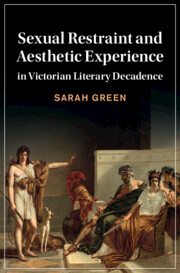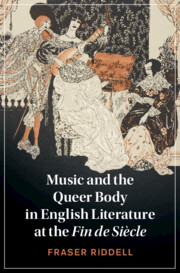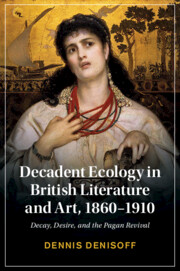66 results
Chapter 15 - A Disembodied Voice, Yet the Voice of a Human Soul
- from Part IV - Interactions
-
-
- Book:
- Victorian Automata
- Published online:
- 15 March 2024
- Print publication:
- 28 March 2024, pp 314-332
-
- Chapter
- Export citation
Chapter 5 - A Psychological Critique
- from Part III - Nietzsche’s Mature Rejection of the ‘Pessimism of Sensibility’
-
- Book:
- Nietzsche's Struggle against Pessimism
- Published online:
- 02 November 2023
- Print publication:
- 16 November 2023, pp 155-197
-
- Chapter
- Export citation
Chapter 2 - The Beautiful and Damned and Literary Decadence
-
-
- Book:
- The Cambridge Companion to F. Scott Fitzgerald
- Published online:
- 26 October 2023
- Print publication:
- 09 November 2023, pp 38-53
-
- Chapter
- Export citation
Chapter 12 - The Conservative and Patriotic 1890s
-
-
- Book:
- Nineteenth-Century Literature in Transition: The 1890s
- Published online:
- 17 August 2023
- Print publication:
- 07 September 2023, pp 246-263
-
- Chapter
- Export citation
Chapter 13 - Decadence and the Antitheatrical Prejudice
-
-
- Book:
- Nineteenth-Century Literature in Transition: The 1890s
- Published online:
- 17 August 2023
- Print publication:
- 07 September 2023, pp 264-284
-
- Chapter
- Export citation
Chapter 8 - “Only Nature Is a Thing Unreal”: The Anthropocene 1890s
-
-
- Book:
- Nineteenth-Century Literature in Transition: The 1890s
- Published online:
- 17 August 2023
- Print publication:
- 07 September 2023, pp 170-186
-
- Chapter
- Export citation
Chapter 11 - Eugenics and Degeneration in Socialist-Feminist Novels of the Mid-1890s
-
-
- Book:
- Nineteenth-Century Literature in Transition: The 1890s
- Published online:
- 17 August 2023
- Print publication:
- 07 September 2023, pp 227-245
-
- Chapter
- Export citation
Chapter 2 - Island Dandies, Transpacific Decadence, and the Politics of Style
-
-
- Book:
- Nineteenth-Century Literature in Transition: The 1890s
- Published online:
- 17 August 2023
- Print publication:
- 07 September 2023, pp 41-60
-
- Chapter
- Export citation
Chapter 12 - Wealth and Decadence in Plutarch’s Lives
-
-
- Book:
- The Cambridge Companion to Plutarch
- Published online:
- 29 June 2023
- Print publication:
- 13 July 2023, pp 243-260
-
- Chapter
- Export citation

Sexual Restraint and Aesthetic Experience in Victorian Literary Decadence
-
- Published online:
- 02 March 2023
- Print publication:
- 09 March 2023
Chapter 20 - European Literature
- from Part III - Literature, the Arts, and Intellectual Life
-
-
- Book:
- Tolstoy in Context
- Published online:
- 05 January 2023
- Print publication:
- 22 December 2022, pp 163-170
-
- Chapter
- Export citation
Chapter 5 - Richard Bruce Nugent’s “Geisha Man”
- from Part III - Decadent Modernism and Eroticized Kinship
-
- Book:
- Queer Kinship after Wilde
- Published online:
- 15 September 2022
- Print publication:
- 06 October 2022, pp 159-185
-
- Chapter
- Export citation
Chapter 4 - Decadent Bachelordom and Transnational Adoption
- from Part II - Queer Retreat and Cosmopolitan Community
-
- Book:
- Queer Kinship after Wilde
- Published online:
- 15 September 2022
- Print publication:
- 06 October 2022, pp 126-156
-
- Chapter
- Export citation

Music and the Queer Body in English Literature at the Fin de Siècle
-
- Published online:
- 15 April 2022
- Print publication:
- 14 April 2022
-
- Book
-
- You have access
- Open access
- Export citation
Chapter 1 - Decadent Ecology and the Pagan Revival
-
- Book:
- Decadent Ecology in British Literature and Art, 1860–1910
- Published online:
- 09 December 2021
- Print publication:
- 16 December 2021, pp 7-33
-
- Chapter
- Export citation
Introduction
-
- Book:
- Decadent Ecology in British Literature and Art, 1860–1910
- Published online:
- 09 December 2021
- Print publication:
- 16 December 2021, pp 1-6
-
- Chapter
- Export citation

Decadent Ecology in British Literature and Art, 1860–1910
- Decay, Desire, and the Pagan Revival
-
- Published online:
- 09 December 2021
- Print publication:
- 16 December 2021
Chapter 12 - Transitions, Turns
- from Part III - Aesthetics
-
-
- Book:
- British Literature in Transition, 1900–1920: A New Age?
- Published online:
- 07 December 2021
- Print publication:
- 02 December 2021, pp 229-243
-
- Chapter
- Export citation
Chapter 2 - Reinventing Wonderland: Jabberwocks, Grotesque Monsters, and Dinosaurian Maladaptation
-
- Book:
- Reimagining Dinosaurs in Late Victorian and Edwardian Literature
- Published online:
- 28 October 2021
- Print publication:
- 04 November 2021, pp 63-98
-
- Chapter
- Export citation
Chapter 3 - Rearticulating the Nation: Transatlantic Fiction and the Dinosaurs of Empire
-
- Book:
- Reimagining Dinosaurs in Late Victorian and Edwardian Literature
- Published online:
- 28 October 2021
- Print publication:
- 04 November 2021, pp 99-135
-
- Chapter
- Export citation



